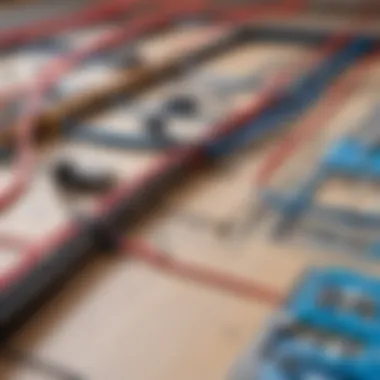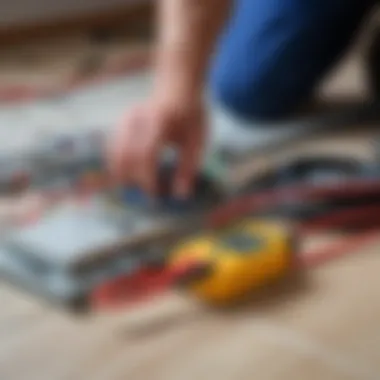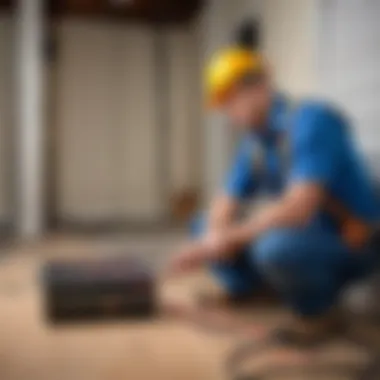Mastering Electrical Wiring for Floor Installations


Intro
Electrical wiring beneath flooring is a critical aspect of modern interior construction and renovation projects. It allows for a clean aesthetic by hiding unsightly cables and improving safety by reducing trip hazards. Understanding how to properly design and install these systems provides not only peace of mind but also enhances the functionality of electrical features in your home. This comprehensive guide is tailored for DIY enthusiasts, interior designers, and builders seeking to understand the nuances of laying electrical wiring under floors.
Проектирование и планирование
Как выбрать проект для DIY
Selecting the right plan for your DIY project is the foundation of success. Assess your needs and objectives carefully. Ask yourself:
- What type of electrical installations do you need?
- Are you looking to install outlets, lighting, or perhaps heating systems under the floor?
- What are the specific requirements of the space you are working in?
Once you’ve established your goals, research existing projects for inspiration. Websites like reddit.com and facebook.com/groups can provide valuable insights and ideas from fellow DIYers and professionals.
Оценка времени и ресурсов
Next, evaluate the time and resources at your disposal. Calculate an estimated timeline for your project. Factor in all stages: planning, procurement of materials, installation, and possible troubleshooting. Consider the following:
- Skill Level: How experienced are you with electrical work?
- Tools Needed: Will you need to rent equipment or buy new tools?
- Budget: What is your financial limit for materials and tools?
By conducting a thorough assessment in the planning stage, you’ll be better prepared for potential challenges and unexpected delays.
Выбор материалов
Choosing the right materials for your electrical wiring project is crucial for ensuring both safety and performance. Various factors play a role in these decisions.
Типы материалов для различных проектов
Different projects necessitate distinct materials. Generally, you will encounter:
- Electrical Conduit: PVC or metal conduits protect wires and ensure compliance with codes.
- Wiring: Use durable wiring rated for the layout and application—think about options like Romex or UF cable for specific environments.
- Connectors and Junction Boxes: These are vital for securing connections and maintaining safety standards.
Be sure to consult local building codes, as they might dictate specific materials for certain installations.
Советы по покупке и экономии
When purchasing materials, keep in mind the importance of balancing quality with cost. Here are a few tips:
- Buy in Bulk: For large projects, this strategy can lead to significant savings.
- Visit Local Supply Stores: Often, these stores provide better deals than big box retailers.
- Explore Second-Hand Options: Check online marketplaces for reusable materials.
Researching and evaluating your material options will ensure you make informed choices that align with your project's requirements and budget.
Adequate planning and careful selection of materials are the linchpins of a successful electrical wiring installation beneath floors.
Preamble to Floor Electrical Wiring
Floor electrical wiring involves the strategic placement of electrical systems beneath flooring surfaces. This aspect of residential wiring plays a crucial role in modern construction and renovation projects. By planning and executing a proper layout, one can ensure a seamless integration of electrical components while maintaining the aesthetic appeal of living spaces. Understanding this topic is vital for several reasons, including safety, functionality, and efficiency.
The modern homeowner or designer must be aware of the increasing reliance on technology in daily life. Electrical wiring enables the installation of outlets, lighting, and even heating systems that integrate with the floor. This creates a more usable and comfortable environment. However, when implementing such systems, consideration must be given to both design and compliance with safety regulations.
Inefficient wiring can lead to significant issues. A poorly planned system can result in increased energy costs and potential hazards such as short circuits or electrical fires. Taking time to understand floor electrical wiring layout allows for the preemptive identification and resolution of these risks.
This section serves as a foundation for exploring the various facets of floor electrical wiring. As we delve deeper into this article, we will unpack the need for concealed wiring, benefits, and the challenges that might arise during the installation process.
Understanding the Need for Concealed Wiring


Concealed wiring refers to the practice of hiding electrical cables and connections beneath the flooring. This method serves many purposes. Primarily, it helps create a clean and uncluttered appearance in living spaces. When wires are hidden, it significantly enhances the aesthetic appeal of a home by eliminating exposed cables that can detract from interior design.
Moreover, concealed wiring can protect electrical systems from damage. By placing wires underneath floors and in walls, they are less susceptible to wear and tear, pests, and accidental cuts. It also prevents trip hazards associated with exposed cords, a common concern in household environments.
In addition to safety and aesthetics, there are functional advantages. Installing outlets at strategic locations beneath the floor provides convenience for furniture arrangement. This arrangement allows options for more flexible layouts without the need to compromise on functionality.
Exploring Benefits and Challenges
The benefits of utilizing concealed wiring are numerous. First, there’s the improvement in safety. With hidden wiring, there’s a reduced risk of electrical shock or fire hazards caused by damaged insulation. Second, there is increased home value, as buyers often prefer houses that have integrated and hidden systems.
On the other hand, challenges do exist when it comes to floor electrical wiring installations. One of the primary concerns is the need for thorough planning. Not only must you design a layout that supports the power needs of the space, but you must also ensure compliance with local building codes.
Furthermore, installation can vary in complexity. If the existing flooring requires significant alterations, costs can rise correspondingly. This leads to the potential necessity for professional help, particularly for those without experience in electrical work.
It's important to weigh these benefits against the challenges for anyone considering a floor electrical layout. Understanding these elements can lead to informed decisions about your project's direction.
Planning Your Wiring Layout
Planning the wiring layout for floor installations is essential for creating effective and safe electrical systems within any building. A well-thought-out wiring plan reduces the chances of costly mistakes and ensures the system operates efficiently.
Assessing Your Space
Before any installation begins, it is important to assess the specific characteristics of the space where electrical wiring will be laid. Consider the dimensions, layout, and purpose of the area, as these factors will influence the placement of electrical outlets and wiring.
For instance, when working in a living room versus a kitchen, the approach may differ greatly due to varying requirements for lighting and electrical appliances. Measure distances between walls and identify existing features, such as doorways and windows, that could impact the wiring installation. Additionally, consider how the layout will affect foot traffic and furniture placement, ensuring that outlets are conveniently located while adhering to safety standards.
Determining Power Needs
Understanding the power needs for each section of the installation is vital. Start by identifying all devices and appliances that will be used in the space. These can include lights, heaters, or electronic devices.
Once you have a list, calculate the power requirements for each item. This calculation involves knowing the voltage and amperage ratings of devices, which can usually be found on their labels. A common standard is to allow 15 to 20 amps for general lighting and outlets. It is crucial to ensure that the total load does not exceed the capacity of the electrical circuit to prevent potential hazards. In essence, determining the correct power needs facilitates a well-configured layout that promotes safety and function.
Creating an Efficient Wiring Diagram
Creating an efficient wiring diagram is the next step in the planning process. This diagram will serve as a visual representation of the planned routing of wiring and the associated electrical components. It should include locations for outlets, switches, and fixtures, as well as pathways for the wiring itself.
To create this diagram, consider the following steps:
- Sketch the Floor Plan: Draw the basic layout of the room to scale. This provides a solid foundation for the wiring plan.
- Mark Electrical Components: Indicate placements for outlets, switches, and junction boxes clearly.
- Plan the Wiring Runs: Develop lines or paths that show where the wiring will run, minimizing the distance to reduce potential signal loss.
- Include Circuit Information: Label circuits for easy reference.
This wiring diagram will then provide clarity during installation, making it easier to assess changes or troubleshooting in the future.
"A well-planned wiring layout sets the foundation for an electrical system that is both efficient and long-lasting."
Overall, planning your wiring layout is a crucial step that impacts the entire installation process. By taking the time to assess your space, determine power needs accurately, and create an efficient wiring diagram, you are paving the way for a safe and effective electrical system.
Materials and Tools Required
When it comes to electrical wiring beneath floors, selecting the right materials and tools is essential. Proper materials ensure safety and efficiency, while the right tools facilitate a smooth installation process. Without these, even a well-planned layout may lead to problems down the line. Making informed choices can result in a reliable electrical system that fits the needs of any space, whether it is a residential or commercial building.
Choosing the Right Cables
The selection of cables is paramount for any floor wiring project. Cables must be appropriate for the intended load and environment. This involves choosing the correct gauge, which determines how much current the wire can handle. Common options include Romex and non-metallic sheathed cables, often used for home wiring. It is also vital to consider the insulation type. For installation beneath floors, cables should be rated for the intended use, such as moisture resistance if placed in a humid area. Always refer to local electrical codes to ensure compliance.
"Using the right cable can prevent overheating and electrical fires, so careful selection cannot be overstated."
Insulation and Safety Gear


Insulation materials serve multiple purposes in electrical installations. They protect cables from environmental factors and help maintain energy efficiency. For beneath-floor installations, rigid insulation boards or batt insulation can be used effectively. Beyond insulation, employing safety gear during installation is critical. This includes insulated gloves, safety glasses, and hard hats. Protecting oneself against electrical hazards should always be prioritized, and wearing proper gear helps prevent accidents. Furthermore, ensuring that all materials are fire resistant adds another layer of safety.
Essential Tools for Installation
Equipping oneself with the right tools can significantly impact the efficiency and safety of the installation process. A few essential tools include:
- Wire cutters and strippers: Necessary for preparing cable ends.
- Drill and drill bits: Used for making holes and routing wires through walls or floors.
- Screwdrivers: Essential for securing plates and connections.
- Multimeter: A crucial tool for measuring voltage, current, and resistance.
Using quality tools not only makes the work easier but also increases accuracy. Investing in reliable equipment is smart for any homeowner or contractor looking to perform quality workmanship.
Installation Techniques
Understanding the installation techniques for electrical wiring under floors is crucial to ensuring safety and functionality. Proper installation can prevent potential hazards, improve efficiency, and ensure compliance with local regulations. By paying attention to specific elements like wiring layout and power connections, DIY enthusiasts and professionals alike can achieve a successful floor electrical system.
Preparing the Subfloor
Before any wiring installation can begin, it is essential to prepare the subfloor adequately. This step sets the stage for wiring placement and can influence the overall installation process. Begin by ensuring the subfloor is dry, clean, and level. Any debris or uneven areas could hinder the wiring installation and damage the cables.
Once the subfloor condition is assessed, mark the desired layout for the wiring. Depending on the final use of the spaces, plan for future access needs. It's wise to consider additional wiring needs for potential future projects as well.
Key Points in Preparing the Subfloor:
- Remove any moisture with proper drying methods.
- Clean up dust and debris effectively.
- Level any uneven surfaces.
- Make layout marks to guide cable placement.
Laying Out the Wiring
With the subfloor prepared, attention can now shift to laying out the wiring. A clear wiring diagram will aid in the process. Ensure that all cables are routed away from any wet areas, like potential sources of leaks or bathroom zones. The manner in which wires are laid out can significantly impact both functionality and safety.
When laying down the wire, use cable staples or straps to secure the wiring in place. Each wire should be spaced appropriately to avoid overheating and interference. Make sure to comply with local codes regarding minimum distances between cables as well.
Tips for Laying Out Wiring:
- Clearly identify the routes for each component on your wiring diagram.
- Keep pathways organized and tidy for easier identification.
- Use appropriate securing methods to prevent movement.
Connecting to Power Sources
The final stage in the installation process involves connecting the wiring to power sources. This section demands meticulous attention to detail, as improper connections can lead to short circuits or other electrical hazards. It is important to locate the power source and choose the proper connectors for your specific wiring type.
Check that all connections are tight and secure. Loose connections are a common cause of electrical faults. Use junction boxes to house connections when necessary, which also allows for easier inspection and maintenance in the future.
Important Notes for Connecting to Power Sources:
- Always verify if the power is off before working.
- Double-check compatibility between wires and connectors.
- Respect current and voltage limits.
Proper installation techniques safeguard the efficiency and safety of electrical systems beneath floors.
By focusing on these areas during the installation process, anyone can create a robust and reliable electrical wiring setup. Make sure to follow best practices and local codes for a successful project.
Safety Considerations
Ensuring safety during electrical installations is paramount. Ignoring safety measures can lead to severe accidents, which may result in injuries or property damage. When working with electrical wiring beneath flooring, understanding the pertinent safety regulations is crucial. By prioritizing safety, one can avoid hazards and comply with legal standards set forth by electrical codes.
Understanding Electrical Codes
Electrical codes establish the guidelines necessary for safe wiring practices. These codes vary by region, but they share common goals: protecting people and property from electrical hazards. Familiarizing oneself with local electrical codes helps ensure compliance and enhances overall safety.


Among the significant aspects of electrical codes is the requirement for proper insulation and grounding. These standards help prevent electrical shocks and fires. Moreover, codes stipulate the types of cables suitable for specific installations. Using the correct materials ensures that the wiring can withstand the conditions it will face under the flooring.
Fines and liability can arise from neglecting electrical codes. Homeowners and contractors must adhere to these rules to mitigate potential risks. Checking websites like en.wikipedia.org for detailed information about local codes can be beneficial.
Common Hazards to Avoid
Certain hazards are prevalent in electrical installations under flooring. A few critical areas to consider include:
- Exposed Wiring: Unprotected wires may cause short circuits or even electrocution. Always ensure proper enclosure of all wiring below the floor.
- Moisture: Water damage can corrode electrical components and create short circuits. Evaluate the area for moisture issues before installation.
- Overloading Circuits: Too many devices on a single circuit can lead to overheating. It's important to calculate the load requirements accurately.
- Improper Connections: Failure to securely connect wires may lead to arcing, which can ignite fires. Take time to verify all connections.
To minimize risks, regular inspections should be conducted post-installation. Identifying and addressing potential hazards early reduces the likelihood of accidents.
Ensuring electrical safety during floor installations is not just a regulatory requirement; it is a vital part of protecting your home and loved ones.
Integrating thorough safety considerations into your electrical projects is an essential step. By applying this knowledge, you will create safer environments and comply with necessary standards.
Troubleshooting Electrical Issues
In any electrical installation, particularly those concealed beneath flooring, issues can arise despite meticulous planning and execution. Understanding how to troubleshoot these problems is essential for ensuring that the wiring functions correctly and safely. Electrical issues can lead to inefficient power supply, equipment damage, or even hazardous situations. By honing troubleshooting skills, one can not only resolve existing issues but also prevent future mishaps, thus enhancing the overall reliability of electrical installations in homes and commercial spaces.
Identifying Common Problems
When working with floor electrical systems, it's crucial to know the signs of potential problems. Common issues may include:
- Power Failure: Devices connected to the circuit may not operate at all.
- Frequent Tripping of Circuit Breakers: This may indicate an overload or a short circuit.
- Flickering Lights: Often a sign of loose connections or poor quality wiring.
- Overheating: Electrical components that become warm to the touch can signify overloading or incorrect installation.
- Strange Noises: Buzzing or popping sounds may indicate issues with the wiring.
Understanding these symptoms can help diagnose problems swiftly. Regular checks on the electrical installations can also aid in early detection of issues, ultimately making the troubleshooting process easier.
Steps for Effective Troubleshooting
When faced with electrical issues, systematic troubleshooting is vital. Here are steps that can be followed to find and fix problems efficiently:
- Ensure Safety First: Always disconnect power before inspecting wiring. Safety precautions must be prioritized.
- Conduct a Visual Inspection: Examine the wiring visually for any signs of damage, loose connections, or improper installations.
- Test Circuit Voltage: Use a multimeter to check for correct voltage levels where devices are connected. This will help determine if power is reaching those points.
- Check Circuit Breakers: Ensure that all circuit breakers are in the correct position and not tripped.
- Use Process of Elimination: If a specific device is malfunctioning, test it on a different circuit to ascertain if the problem lies with the device or the wiring.
- Consult Wiring Diagrams: Compare current wiring setups with original diagrams to track down any discrepancies.
- Seek Professional Help: If issues persist after self-assessment, consult a qualified electrician for a more thorough investigation.
Effective troubleshooting can save time and prevent costly repairs. By following these steps, individuals can tackle electrical problems confidently, ensuring their wiring layouts operate as intended.
Epilogue and Best Practices
When engaging in electrical wiring for floor installations, it is crucial to summarize the primary takeaways while emphasizing best practices. This section synthesizes the detailed information explored in previous parts of the article, offering clear guidance for individuals undertaking such installations.
Understanding Electrcial Systems: Recognizing the fundamentals of how electrical wiring works is essential. Knowledge of basic voltage ratings, current loads, and wire types allows for informed decisions during planning and installation.
Prioritizing Safety: Electrical safety should be the foremost consideration. Familiarizing oneself with relevant electrical codes can help avoid potential hazards. Always ensure that the power is off before beginning any work.
Careful Planning: A well-thought-out wiring diagram is essential. It serves as both a roadmap and a checklist, ensuring all necessary connections are accounted for.
Selecting Quality Materials: Choosing proper cables and equipment influences not only the effectiveness of the installation but also its longevity and safety. High-quality products can significantly reduce the risk of failures in the system.
Regular Maintenance and Checks: After installation, regular maintenance is ideal. This includes checking for any signs of wear, ensuring connections remain secure, and being aware of any changes in power needs as household devices evolve.
Regular assessments of your electrical systems can prevent larger issues down the line.
Recap of Key Points
- Concealed Wiring: Understanding the importance and necessity of concealed wiring in homes to maintain aesthetics and safety.
- Power Requirements: Assessing the home's power needs to avoid overloading circuits.
- Installation Techniques: Proper methods for laying and connecting the wiring to ensure functionality.
- Safety Considerations: Engaging with local electrical codes and understanding common hazards to facilitate safe installations.
Each of these points meets a critical need in setting up effective and safe electrical wiring below floors.
Future Considerations for Electrical Wiring
As technology evolves, electrical systems will also adapt. Home automation and smart technologies are becoming prevalent. Planning for future upgrades is advantageous. For instance:
- Smart Home Integration: Anticipating the need for additional outlets or network cables can enhance the home’s adaptability.
- Energy Efficiency: Considering energy-efficient solutions, like LED lighting or energy-saving devices, can have long-term benefits both for the environment and utility bills.
- Upgrading Capacity: As appliances are upgraded, wiring must often be adjusted to handle increased loads.







